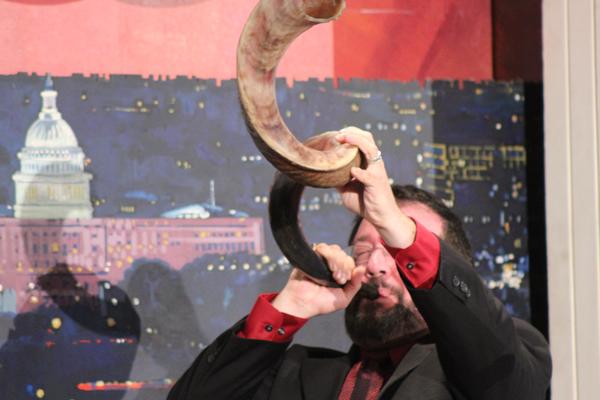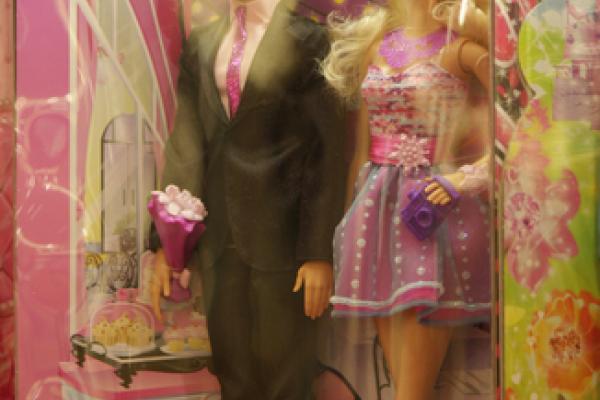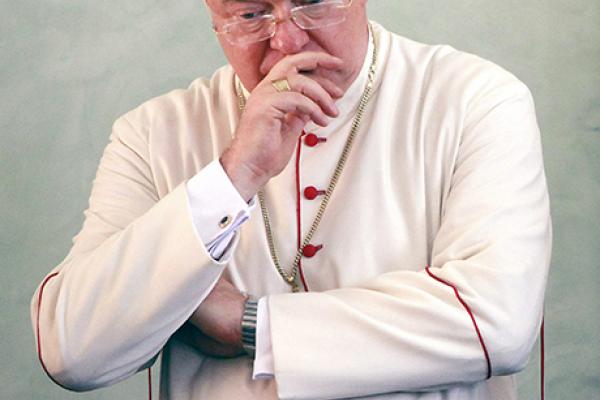A new coalition of atheists, humanists and other nonreligious groups is taking a page from the gay rights movement and encouraging people to admit they are “openly secular.”
The coalition — unprecedented in its scope — is broadening a trend of reaching out to religious people and religious groups by making the secular label a catchall for people who are not religious.
“We wanted to rise above who is an atheist, who is an agnostic, who is a humanist, who is a secular Jew,” said Todd Stiefel, founder of the Stiefel Freethought Foundation and a main force behind the coalition. “This needed to be about something everyone could rally behind so we intentionally used the word secular because it was one thing we could all agree on.”
The campaign, “Openly Secular: Opening Minds, Changing Hearts,” was unveiled at the 65th annual gathering of the Religion Newswriters Association here on Sept. 20. It includes a website, resources for families, employers and clergy, and a YouTube channel featuring both prominent and rank-and-file nonbelievers announcing their names followed by the declaration, “I am openly secular.”
Happy 5775! At sundown on Sept. 24, Jews around the world will turn the page on the Jewish calendar to begin the new year, Rosh Hashanah. What starts with a feast at home will end 10 days later with a fast in the synagogue on Yom Kippur, the Day of Atonement. This time is referred to as “The Days of Awe” as Jews move between repentance and forgiveness, reflection and renewal.
Here’s everything goyim need to know about the High Holy Days so they can holler “L’shanah tovah!” — or “Happy New Year!” — without looking like a shmendrick.
Q: What do Jews celebrate on Rosh Hashanah and Yom Kippur?
A: The new year is celebrated with family and friends, but Jews are also expected to think about the meaning and direction of their lives. How could they have been better Jews? Better human beings? That comes full circle on Yom Kippur, when Jews fast for a whole day and reflect on their faults and the ways they have wronged people throughout the year. It is a holiday for making amends, for seeking and giving forgiveness.
Q: Well, ain’t that a party? Sign me up. KIDDING!
Barbie has had a number of careers in her 55 years — flight attendant, veterinarian, astronaut, even president. Her latest role, however, is raising eyebrows.
Italy’s Catholic bishops are furious about controversial artistic depictions of the popular Barbie and Ken dolls as the Virgin Mary and a crucified Jesus Christ and other saints.
Two Argentinian artists, Marianela Perelli and Pool Paolini, produced 33 dolls of various religious figures for a show named “Barbie, The Plastic Religion,” which opens in Buenos Aires on Oct. 11.
SIR, an Italian website backed by the Italian bishops conference, denounced the controversial toys in an editorial, which asks: ” What is the difference between provocation and bad taste?”
Pope Francis had ordered the arrest of a former Polish archbishop accused of child sex abuse in the Dominican Republic because the case was “so serious,” the Vatican said Sept. 23.
Jozef Wesolowski, who was defrocked by a Vatican tribunal earlier this year, is under house arrest inside Vatican City due to the “express desire” of Pope Francis, the Vatican said in a statement.
“The seriousness of the allegations has prompted the official investigation to impose a restrictive measure that … consists of house arrest, with its related limitations, in a location within the Vatican City State,” the Vatican’s chief spokesman, the Rev. Federico Lombardi, said.
Wesolowski was removed from his position in the Dominican Republic and recalled to the Vatican in August 2013 amid claims that he had abused boys in Santo Domingo.
The former archbishop is awaiting trial on criminal charges at the Vatican and could eventually face charges in the Dominican Republic and in his native Poland.
Just two days ago at this hour, I was in the midst of an 11-mile journey for John Crawford. Led by young people of color, 85 of us marched through suburban and rural Greene County, Ohio from the Beavercreak Wal-Mart, the site of John Crawford’s death at the hands of police, to Xenia, Ohio, where the special grand jury would consider an indictment of the officers. What was Crawford’s “crime?” Carrying a toy gun around Wal-Mart while talking on a cell phone.
During the march, there were moments when I felt like we had gone back in time, to days of struggle in the rural South, pushing for black lives to matter in this country, from accommodations to the ballot box. Things were different, I thought. Fifty years ago, marchers had a legitimate fear of sniper fire. Buses carrying freedom riders were attacked and firebombed with impunity. Surely times have changed.
Today the grand jury in Ohio announced there will be no indictment of the officers. (The Justice Department later announced it is launching an investigation into the shooting.) The Wal-Mart surveillance video is now public, and it reveals how quickly Crawford’s life was taken. The special prosecutor, in quotes about the case, seems to have not pushed very hard for an indictment. So another black life is lost under absurd circumstances, and the system communicates yet again that black lives don’t matter.
These are anxious times for white evangelicals, according to two new surveys.
At 20 percent of U.S. adults, they are statistically neck-and-neck with the “nones” — people who claim no religious brand. “Nones” now tally up to 19 percent in the 2014 American Values Survey, said Robert Jones, CEO of the Public Religion Research Institute, which released the survey Sept. 23.
Evangelicals, said Jones, are on “the losing side of the culture wars, such as gay marriage, and they see that their share (of society) is shrinking and aging, adding to their sense of being embattled.”
“They can no longer say confidently they speak for all people of faith.”
Perhaps for that reason, white evangelicals, more than any other religious group, worry that the government will interfere with their religious liberty.
The survey asked which concerned people more: The government interfering with their ability to “freely practice their religion” or “religious groups trying to pass laws that force their beliefs on others.”
The overall answer was a tie — 46 percent of Americans overall for each viewpoint. But white evangelicals were significantly more worried about government interference (66 percent) than any other group.
What an amazing weekend! Barbara, Peter, and I had the privilege of hosting more than forty students from Christian colleges who traveled to New York for the People’s Climate March. On Sunday, we joined with other Christians for a morning prayer service in Central Park, and then squeezed in with an estimated 311,000 people for what is hands-down the biggest climate demonstration ever.
We had our choice of groupings on the march. Leading the way were those already affected by climate disruption, followed by students, youth, and elders. Fifteen blocks back stood those working for solutions, such as renewable energy and environmental justice advocates. Another ten blocks and the scientists and faith groups stood shoulder-to-shoulder. And in the rear was an assortment of cities, states and countries from virtually everywhere.
We chose the Science and Faith section. There we were, beneath an enormous blackboard prepared by scientists declaring “The ‘Debate’ is Over!”
Its chalk markings depicted the trends in atmospheric CO2 concentrations over the last 400,000 years, with the unprecedented and terrifying spike in the last half-century; a pie-chart of the 97 percent of climate scientists who agree on the consensus science of manmade global warming; a line graph showing the precipitous decline in Arctic sea ice cover; and the Keeling Curve demonstrating the inexorable growth in greenhouse gases every single year. Around us stood technicians in white lab coats, research scientists of every stripe, Christian college students, university professors, grandmothers demanding climate action, and young parents pushing strollers—including our own kids, Lindsey and Brad, with our beautiful granddaughters.
The debate is over. Right?
Here at Sojourners we have written a lot about nonviolence. We take seriously the words of Jesus that we should love our enemies and pray for those who persecute us. We believe that violence begets violence, or as Jesus put it, “Those who live by the sword die by the sword.” Personally, I take seriously the words of René Girard, the founder of mimetic theory, that we are now “confronted with a perfectly straightforward and even scientifically calculable choice between total destruction and the total renunciation of violence.”
Many Christians look to the Bible to justify divinely sanctioned violence against our enemies. Excuse me for stating the obvious, but Christians are not Biblians. We are Christians. As Christians, we should be putting Jesus first. Not Deuteronomy. Not Joshua. Not Judges. Not David. Not Solomon. Not Peter. Not Paul. Not the Bible.
Jesus first.
And Jesus calls us to nonviolence. As one of the early Christians stated, the way of Jesus, the way of nonviolent love that embraces our enemies, is the way of the cross and the world thinks that way is foolish.
We proclaim Christ crucified, a stumbling block to the Jews and foolishness to the Gentiles, but to those who are the called, both Jews and Greeks, Christ the power of God and the wisdom of God. For God’s foolishness is wiser than human wisdom, and God’s weakness is stronger than human strength.
Yesterday morning at 5:30 I woke up to a disconcerting email:
Suspicious Sign-In Prevented. Please check your Google activity immediately.
In my half-asleep bleariness, I clicked the link and filled in my password.
Then I realized I'd been scammed.
"Recognize" was spelt "recognise" — and the account email was from Googlemail.com, not Google.com. Otherwise, the email was identical to those I'd gotten from Google in the past.
The next two hours were spent frantically re-securing my life. Changing passwords, adding two-step verification, application passwords.
I suddenly realized how much of my life was online. My Facebook page was a chronicle of my wedding, my jobs, my son's first 2 years of life.
Most people my age are the same way. Sometimes it's easier online.
The first people to find out about my pregnancy three years ago, besides my husband, were members of an online birth month group at WhattoExpect.com. Weeks before we told family or close friends, we shared intimate details about morning sickness, headaches, and faint lines on pregnancy tests.
Why do we do this? Somewhere, all of us, in Fantasy Football groups and pregnancy groups and dog lover groups and gluten-free groups: we're longing for Real Community.
If you’re Jewish, it’s the time of year to do some serious soul-searching.
On Rosh Hashanah, the Jewish new year that begins at sundown on Sept. 24, Jews ask how they could have lived up to their better selves during the previous year, and for forgiveness from God and those they have wronged.
And while they’re not required to make New Year’s resolutions, a lot of Jews do anyway.
“Mine usually revolve around my mother,” said Debbie Sann, a Washington, D.C., mother of two. “I ask God to forgive me for not being a better daughter, and then I resolve to be a better daughter and I say I will call my mother at least once a week.”
Sann is typical of many Jews who make resolutions around Rosh Hashanah — nobody ever discussed the idea with her, or taught it to her in Hebrew school, but she started the practice because it just felt right. In her 20s, walking home from synagogue, she made her first resolution, and has been doing so ever since.
To some — and not always the most traditional of Jews — the practice seems a bit un-Jewish, a little too reminiscent of the quickly abandoned resolutions that spur couch potatoes to dig out their workout gear and join a gym in early January.
But like many Jews who make Rosh Hashanah resolutions, Sann also makes resolutions on Jan. 1. Those are different — she resolves to keep a more organized house, or to work harder. But the ones she makes during the Jewish High Holy Days “are about being a better person,” she said.








